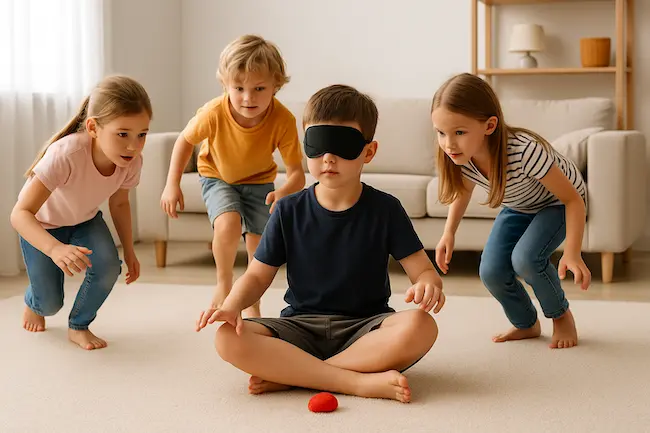If you’re looking for a suspenseful, quiet game that keeps kids fully engaged without chaos, the Sleeping Guard Game is a perfect fit. This indoor group activity is ideal for classrooms, birthday parties, or rainy days, and adds just the right amount of tension and laughter to your playtime.
In this game, one player acts as the “sleeping guard” protecting a treasure while the other children try to steal it—without getting caught. It’s a brilliant mix of observation, self-control, and strategy, and can be played by kids of all ages.
Whether you’re planning a calm classroom game or looking for something unique for your next party, the Sleeping Guard Game is easy to organize, endlessly fun, and surprisingly educational.
Why Your Kids Will Love the Sleeping Guard Game
This game is a favorite among children because it feels like a challenge and a secret mission all in one. Here’s why kids can’t get enough of it:
- It creates suspense and excitement without noise or running.
- Children get to role-play as guards or sneaky thieves, which fuels imagination.
- It’s a quiet game, perfect for classrooms or when you need to keep the energy calm.
- The rules are simple, but winning requires focus and coordination.
- It invites multiple rounds and gives everyone a chance to be the guard.
With its simple setup and fun theme, this game encourages teamwork, observation, and self-control.
If your kids love bluffing and quick thinking, they’ll have a blast playing our Spyfall-inspired guessing challenge, where every round is filled with mystery and laughter.
Game Overview
Let’s quickly review the key points of the Sleeping Guard Game to help you set it up quickly and easily:
- Number of players: Minimum 3, works great with medium-sized groups
- Recommended age: 5 years and up
- Setting: Indoors (classroom, living room, party space)
- Duration: 10 to 20 minutes per round
- Game type: Observation, stealth, and role-play
- Supplies: One object to “guard” (toy, ball, key), a blindfold or chair
This easy-to-learn game is an excellent icebreaker and helps settle the mood while keeping kids engaged.
Challenge young word‑nerds with our Jumble Tumble word scramble relay game, where kids race to rearrange giant letters and guess the secret word aloud!
How to Play the Sleeping Guard Game
Setting up the game is quick, and kids will intuitively understand the rules once the first round begins. Here’s how to play step by step:
- Choose one player to be the “sleeping guard” and have them sit on a chair or floor with a blindfold or closed eyes.
- Place a small object (“the treasure”) in front of them—this is what they must protect.
- The rest of the children line up a few feet away.
- One by one—or all at once, depending on the variation—players try to creep up quietly and grab the treasure.
- If the guard hears a sound, they can point in the direction they think the thief is.
- If they point correctly, the thief is caught and goes back to the start.
- If someone manages to grab the object without being detected, they become the next guard.
This game works best with multiple rounds and rotating roles so everyone gets a turn in the spotlight.
If you’re searching for a clue‑filled twist on acting games, check out our exciting Charades Relay race game for kids, where gesture, guessing and teamwork combine for nonstop laughter!
Game Variations to Try
Once the basic version is mastered, you can introduce new twists to keep the game fresh:
- Musical Mode: Play soft suspenseful music to add tension (and cover sneaky steps).
- Multiple Treasures: Add more than one item to be protected—harder for the guard!
- Animal Challenge: Players must approach using animal-style moves (crab walk, tiptoeing, crawling).
- Guess Who: If the guard catches someone, they must guess who it was by voice or clues.
These small changes add new dimensions to the game while keeping the core mechanics intact.
If you’re planning a group activity full of suspense and sly moves, try our Killer Handshakes secret‑agent game—perfect for parties where kids must spot the hidden player.
Educational Benefits of the Sleeping Guard Game
The Sleeping Guard Game isn’t just fun—it offers real educational value in a playful format. Here are some benefits children gain while playing:
- Improved self-control: Kids must remain quiet, still, and focused under pressure.
- Sensory awareness: Players develop sharper hearing and spatial awareness.
- Social skills: The game encourages turn-taking, fair play, and respecting others’ roles.
- Creative role-playing: Kids explore imagination through characters and scenarios.
- Cognitive flexibility: Switching between guard and thief roles builds mental adaptability.
These advantages make it a favorite among teachers and parents alike, especially in structured environments.
If your child enjoys deduction and observation, check out our full selection of clever guessing games for kids, perfect for parties or classroom fun.
FAQ – Sleeping Guard Game
- Can this game be played in a classroom setting?
Absolutely! This game is perfect for classrooms. It requires minimal space, encourages calm behavior, and offers a fun break between lessons. - How many children can play at once?
While 3 to 8 players is ideal, the game can be adapted for larger groups by rotating players in shorter rounds or creating teams. - What if the child playing the guard opens their eyes?
You can use a blindfold or remind them gently to keep their eyes closed. Most kids take the role seriously and enjoy the suspense. - What age is best for this game?
Children aged 5 and up can easily understand the rules and enjoy the suspense. Older kids may enjoy the strategic and competitive aspects even more. - Can I adapt this game for a holiday party?
Definitely! Try calling it the “Sleeping Santa” or “Pumpkin Guard” game and replace the treasure with a seasonal item.
The Sleeping Guard Game is versatile and easy to customize—making it a staple for indoor group play.
For more structured adventures, explore our printable mystery kits for kids aged 4 to 12, including detective games, escape rooms, and treasure hunts ready to play at home.






